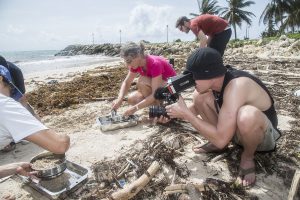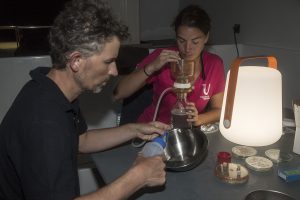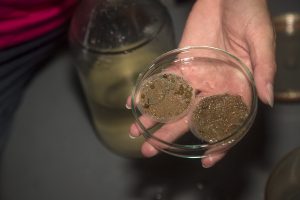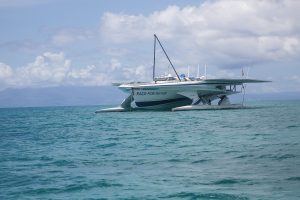Over the past two weeks, six European scientists from the Ephemare project have been aboard the Race for Water vessel to study the plastic pollution of the oceans. What are the protocols, the aims and the techniques used? Explanations from Bénédicte Morin, teacher and research at the University of Bordeaux.

Six European scientists from the Ephemare study project sampling beaches to learn about plastic pollution.
Race for Water (R4W): What have you come to study in the waters around Guadeloupe and how is this approach breaking new ground?
Bénédicte Morin (BM): We’ve come to study the quantity, the type and the toxicity of the microplastics present in various environments within the ecosystem. We’ve tested four of these environments: sand, sediment, water and biota (the latter corresponds with individuals living in the marine environment). During the 2015 odyssey, we studied pollution via microplastics from the beach environment the world over. This time, we’re interested in having a global vision of the plastic contamination through the study of various areas spanning the same sampling site.

On board, the first analyses !
R4W: How do you obtain samples of microplastics in these different areas?
BM: On the beaches, we use a quadrant technique, which means delimiting a zone on the beach so as to quantify and then qualify the microplastics present on site. With regards to the surface of the water, we tow ‘nets’ behind the vessel. We collect microplastics or plankton, very small organisms at the root of the food chain, according to the size of the mesh for each net. In order to test the sediment (gravel, sand or mud found at the bottom of the water), we dive down and pick up a sample of the soil with the help of a Van Veen grab. To round off our work, we bought some fish from the local fishermen and then dissected them so we could analyse the presence of microplastics in the digestive tract. We were able to take samples from organisms such as sea urchins and oysters near the beaches sampled.

Studiing sand and sediment to understand all cycle of plastic pollution.
R4W: What results have you amassed from this sampling?
BM: For now, we’ve only completed the ‘harvesting’ stage. All our samples will be sent off to our universities in Italy and France. The characterisation of microplastics is a procedure that is carried out in a laboratory environment and requires a certain amount of time.
However, we’ve chosen to study two sites in Guadeloupe: one on the eastern seaboard of the island of Basse Terre and the other on south-eastern seaboard of the island of Marie-Galante, so those that have debris from the Atlantic washing up on their beaches. We’ve observed a greater abundance of macro and microplastic on the eastern seaboard of the island of Marie-Galante probably linked to the waste carried along by the currents that make up the North Atlantic gyre, which notably include a vast amount of fibre from fishing activities. The Basse Terre site, despite being located on the Atlantic coast, is probably protected from the waste by the neighbouring island of Grande Terre.

Propulsed by renewables energies, the Race for Water vessel is used by scientists to study plastic pollution in Guadeloupe.
R4W: In conclusion, what do you think of this oceanic campaign with the Race for Water Foundation?
BM: Quite frankly, I’m delighted and I’m sure my colleagues are too. The vessel is incredibly spacious and we can carry out some high-quality work on her, added to which the teams aboard the boat have given us a very warm welcome. It’s just extraordinary to be able to carry out oceanic studies without any environmental impact and noise-free thanks to this vessel being propelled by clean energies.